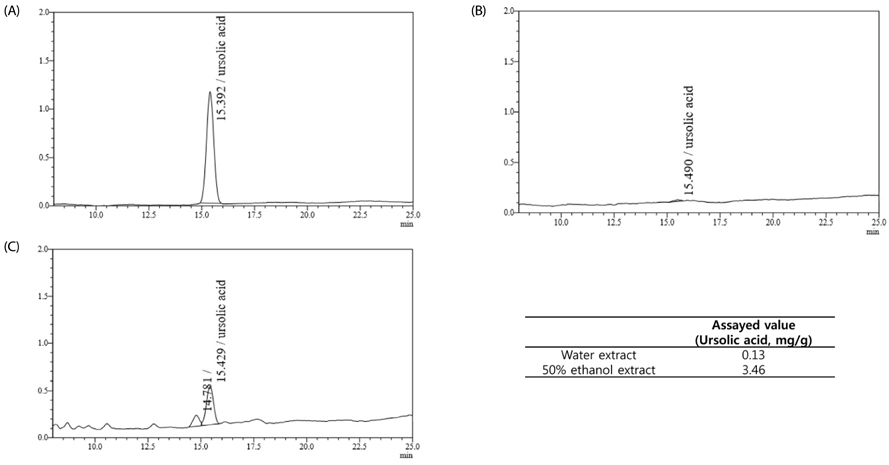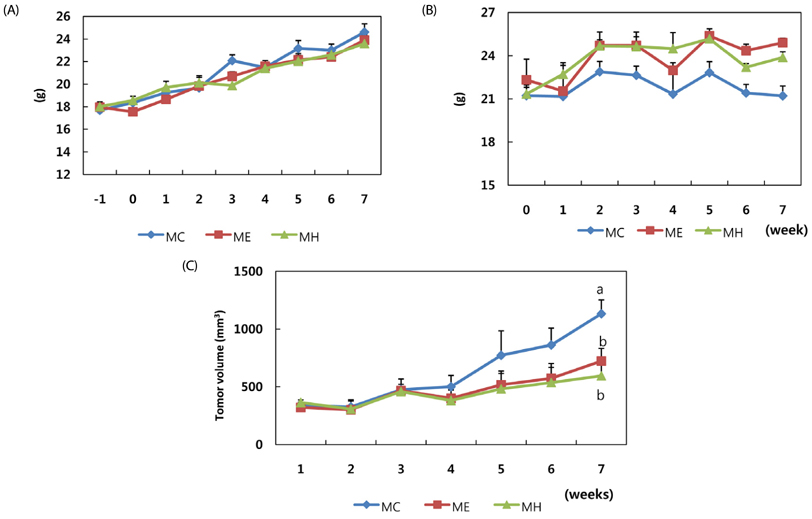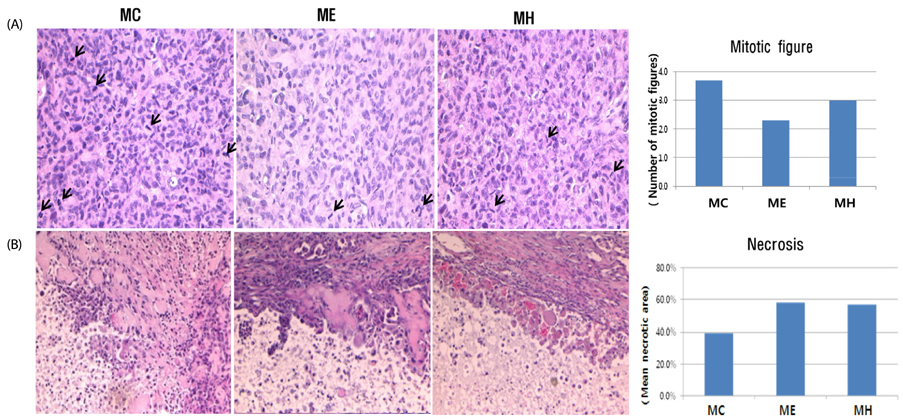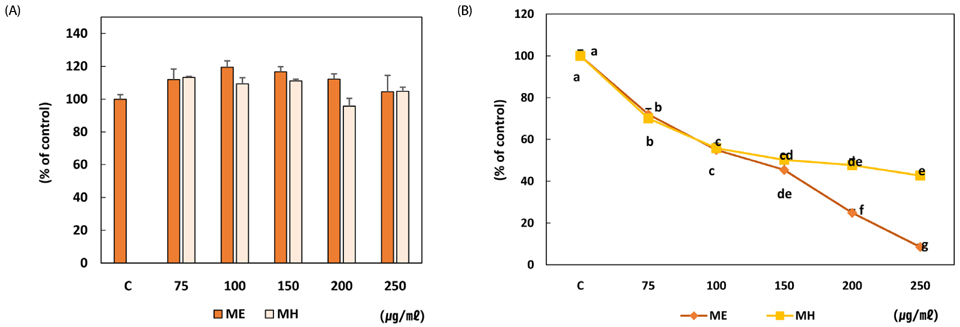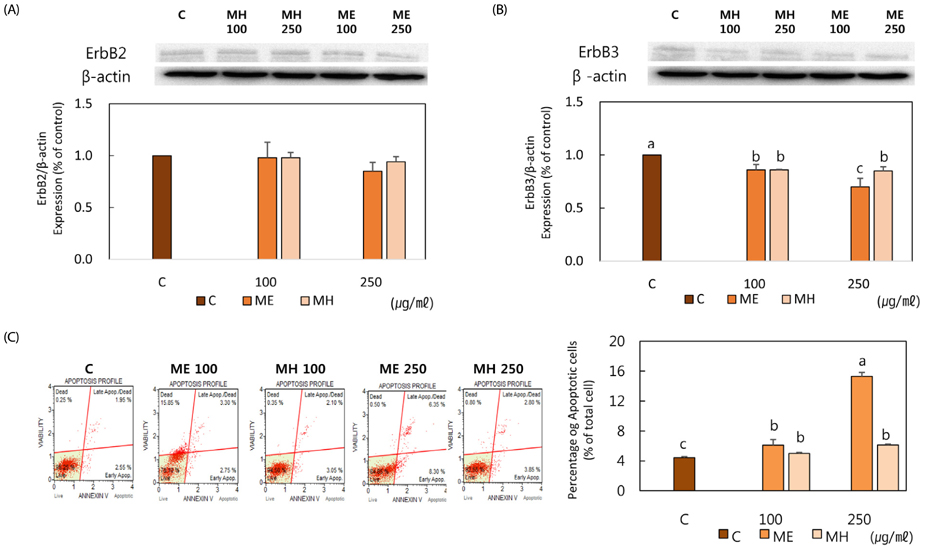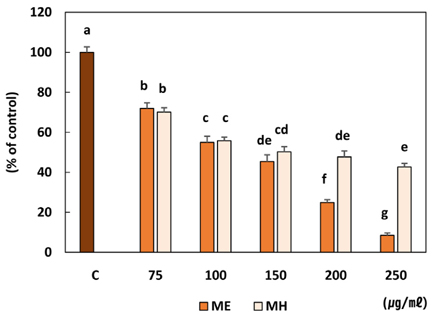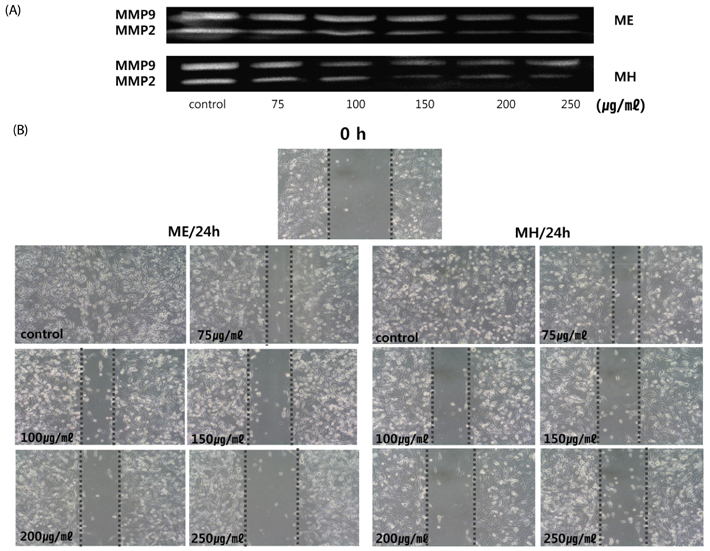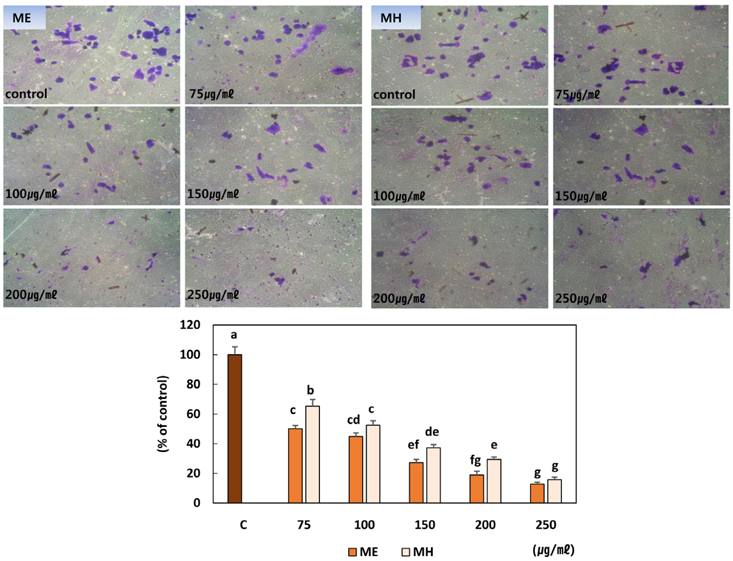Nutr Res Pract.
2016 Apr;10(2):139-147. 10.4162/nrp.2016.10.2.139.
Loquat (Eriobotrya japonica) leaf extract inhibits the growth of MDA-MB-231 tumors in nude mouse xenografts and invasion of MDA-MB-231 cells
- Affiliations
-
- 1Department of Food and Nutrition / Research Institute of Human Ecology, Mokpo National University, 1666, Yeongsan-ro, Cheonggye-myeon, Muan-gun, Jeonnam 58554, Korea. kha@mokpo.ac.kr
- 2Hisol, 247-9, Baraebong-gil, Unbong-eup, Namwon-si, Jeonbuk, Korea.
- 3Department of Pathology, College of Veterinary Medicine, Kyungpook National University, Daegu 41566, Korea.
- 4Korea INSpharm Research institute, 1065 Daepo-ri, Dong-myeon, Hwasun-gun, Jeonnam 58143, Korea.
- KMID: 2313910
- DOI: http://doi.org/10.4162/nrp.2016.10.2.139
Abstract
- BACKGROUND/OBJECTIVES
The present study was conducted to examine the inhibitory effect of loquat leaves on MDA-MB-231 cell proliferation and invasion.
MATERIALS/METHODS
Female athymic nude mice were given a subcutaneous (s.c.) inoculation of MDA-MB-231 cells and randomly grouped to receive a s.c. injection of either 500 mg/kg ethanol, water extract or vehicle five times a week. Tumor growth, mitotic rate and necrosis were examined. MDA-MB-231 cells were cultured with DMSO or with various concentrations of loquat water or ethanol extract. Proliferation, adhesion, migration, invasion and matrix metalloproteinase (MMP) activity were examined.
RESULTS
Tumor growth of xenograft nude mouse was significantly reduced by loquat extracts. The results of mitotic examination revealed that loquat extracts reduced tumor cell division. Both ethanol and water extracts significantly inhibited MDA-MB-231 cell proliferation. The protein expression of ErbB3 was significantly down-regulated by loquat leaf extracts. Loquat leaf extracts increased apoptosis of MDA-MB-231 cells following 24 hour incubation and the ethanol extract was more potent in inducing apoptosis than the water extract. Furthermore, loquat extracts inhibited adhesion, migration and invasion of MDA-MB-231 cells. MMP activity was significantly inhibited by loquat extracts.
CONCLUSION
Our results show that extracts of loquat inhibit the growth of tumor in MDA-MB-231 xenograft nude mice and the invasion of human breast cancer cells, indicating the inhibition of tumor cell proliferation and invasion.
Keyword
MeSH Terms
Figure
Reference
-
1. Radisky ES, Radisky DC. Matrix metalloproteinase-induced epithelial-mesenchymal transition in breast cancer. J Mammary Gland Biol Neoplasia. 2010; 15:201–212.
Article2. Tomaskovic-Crook E, Thompson EW, Thiery JP. Epithelial to mesenchymal transition and breast cancer. Breast Cancer Res. 2009; 11:213.
Article3. Fidler IJ. The pathogenesis of cancer metastasis: the 'seed and soil' hypothesis revisited. Nat Rev Cancer. 2003; 3:453–458.
Article4. Geho DH, Bandle RW, Clair T, Liotta LA. Physiological mechanisms of tumor-cell invasion and migration. Physiology (Bethesda). 2005; 20:194–200.
Article5. Weber GF. Molecular mechanisms of metastasis. Cancer Lett. 2008; 270:181–190.
Article6. Kim MS, You MK, Rhuy DY, Jeong KS, Kim YJ, Baek HY, Kim HA. Oral administration of loquat suppresses DMBA-induced breast cancer in rats. Food Sci Biotechnol. 2011; 20:491–497.
Article7. Liang ZZ, Aquino R, Feo VD, Simone FD, Pizza C. Polyhydroxylated Triterpenes from Eriobotrya japonica. Planta Med. 1990; 56:330–332.
Article8. Shimizu M, Uemitsu N, Shirota M, Matsumoto K, Tezuka Y. A new triterpene ester from Eriobotrya japonica. Chem Pharm Bull (Tokyo). 1996; 44:2181–2182.
Article9. Banno N, Akihisa T, Tokuda H, Yasukawa K, Taguchi Y, Akazawa H, Ukiya M, Kimura Y, Suzuki T, Nishino H. Anti-inflammatory and antitumor-promoting effects of the triterpene acids from the leaves of Eriobotrya japonica. Biol Pharm Bull. 2005; 28:1995–1999.
Article10. Ito H, Kobayashi E, Takamatsu Y, Li SH, Hatano T, Sakagami H, Kusama K, Satoh K, Sugita D, Shimura S, Itoh Y, Yoshida T. Polyphenols from Eriobotrya japonica and their cytotoxicity against human oral tumor cell lines. Chem Pharm Bull (Tokyo). 2000; 48:687–693.
Article11. Kim MS, You MK, Rhuy DY, Kim YJ, Baek HY, Kim HA. Loquat (Eriobotrya japonica) extracts suppress the adhesion, migration and invasion of human breast cancer cell line. Nutr Res Pract. 2009; 3:259–264.
Article12. Park JK, Ki MR, Lee EM, Kim AY, You SY, Han SY, Lee EJ, Hong IH, Kwon SH, Kim SJ, Rando TA, Jeong KS. Losartan improves adipose tissue-derived stem cell niche by inhibiting transforming growth factor-β and fibrosis in skeletal muscle injury. Cell Transplant. 2012; 21:2407–2424.
Article13. Leek RD, Landers RJ, Harris AL, Lewis CE. Necrosis correlates with high vascular density and focal macrophage infiltration in invasive carcinoma of the breast. Br J Cancer. 1999; 79:991–995.
Article14. Zhang ZR, Al Zaharna M, Wong MM, Chiu SK, Cheung HY. Taxifolin enhances andrographolide-induced mitotic arrest and apoptosis in human prostate cancer cells via spindle assembly checkpoint activation. PLoS One. 2013; 8:e54577.
Article15. Hynes NE, Lane HA. ERBB receptors and cancer: the complexity of targeted inhibitors. Nat Rev Cancer. 2005; 5:341–354.
Article16. Holbro T, Beerli RR, Maurer F, Koziczak M, Barbas CF 3rd, Hynes NE. The ErbB2/ErbB3 heterodimer functions as an oncogenic unit: ErbB2 requires ErbB3 to drive breast tumor cell proliferation. Proc Natl Acad Sci U S A. 2003; 100:8933–8938.
Article17. Hynes NE, MacDonald G. ErbB receptors and signaling pathways in cancer. Curr Opin Cell Biol. 2009; 21:177–184.
Article18. Liu J. Pharmacology of oleanolic acid and ursolic acid. J Ethnopharmacol. 1995; 49:57–68.
Article19. Taniguchi S, Imayoshi Y, Kobayashi E, Takamatsu Y, Ito H, Hatano T, Sakagami H, Tokuda H, Nishino H, Sugita D, Shimura S, Yoshida T. Production of bioactive triterpenes by Eriobotrya japonica calli. Phytochemistry. 2002; 59:315–323.
Article20. Ministry of Food and Drug Safety (KR). The Korean Pharmacopoeia. 10th ed. Seoul: Yakup Daily;2013. p. 50–51.21. Kim KH, Seo HS, Choi HS, Choi I, Shin YC, Ko SG. Induction of apoptotic cell death by ursolic acid through mitochondrial death pathway and extrinsic death receptor pathway in MDA-MB-231 cells. Arch Pharm Res. 2011; 34:1363–1372.
Article22. Shanmugam MK, Dai X, Kumar AP, Tan BK, Sethi G, Bishayee A. Ursolic acid in cancer prevention and treatment: molecular targets, pharmacokinetics and clinical studies. Biochem Pharmacol. 2013; 85:1579–1587.
Article23. Shan JZ, Xuan YY, Ruan SQ, Sun M. Proliferation-inhibiting and apoptosis-inducing effects of ursolic acid and oleanolic acid on multi-drug resistance cancer cells in vitro. Chin J Integr Med. 2011; 17:607–611.
Article24. Meng Q, Goldberg ID, Rosen EM, Fan S. Inhibitory effects of Indole-3-carbinol on invasion and migration in human breast cancer cells. Breast Cancer Res Treat. 2000; 63:147–152.
Article25. Johansson N, Ahonen M, Kähäri VM. Matrix metalloproteinases in tumor invasion. Cell Mol Life Sci. 2000; 57:5–15.
Article26. Yeh CT, Wu CH, Yen GC. Ursolic acid, a naturally occurring triterpenoid, suppresses migration and invasion of human breast cancer cells by modulating c-Jun N-terminal kinase, Akt and mammalian target of rapamycin signaling. Mol Nutr Food Res. 2010; 54:1285–1295.
Article27. Cos S, Fernández R, Güézmes A, Sánchez-Barceló EJ. Influence of melatonin on invasive and metastatic properties of MCF-7 human breast cancer cells. Cancer Res. 1998; 58:4383–4390.
- Full Text Links
- Actions
-
Cited
- CITED
-
- Close
- Share
- Similar articles
-
- Loquat (Eriobotrya japonica) extracts suppress the adhesion, migration and invasion of human breast cancer cell line
- Daurisoline Inhibits Progression of Triple-Negative Breast Cancer by Regulating the γγ-Secretase/Notch Axis
- Effect of Curcumin on Cancer Invasion and Matrix Metalloproteinase-9 Activity in MDA-MB-231 Human Breast Cancer Cell
- Inorganic sulfur reduces the motility and invasion of MDA-MB-231 human breast cancer cells
- Novel Suppressive Effects of Ketotifen on Migration and Invasion of MDA-MB-231 and HT-1080 Cancer Cells

